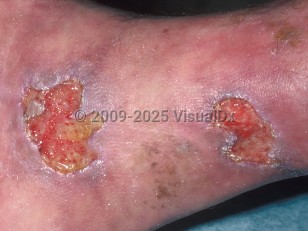To diagnose a factitious disorder, the Diagnostic and Statistical Manual of Mental Disorders requires that the following 3 criteria be met:
- Intentional production or feigning of physical or psychological signs or symptoms,
- Motivation for the behavior is to assume the sick role, and
- Absence of external incentives for the behavior (eg, economic gain, avoiding legal responsibility, and improving physical well-being).
The patient's typical lack of concern for how disfiguring the lesions appear is out of proportion to the reality of their presentation. The patient history never seems to add up to explain the unusual cutaneous findings. This so-called "hollow history" is a characteristic of the disease. There is also a lack of findings to support the diagnosis of an alternative ulcerative process.
The lesions are often produced by digging, picking, biting, cutting, injecting, and puncturing. More serious wounds can be complicated by gangrene, abscess formation, or other life-threatening infections. Treatment is often challenging and requires a multidisciplinary approach.



